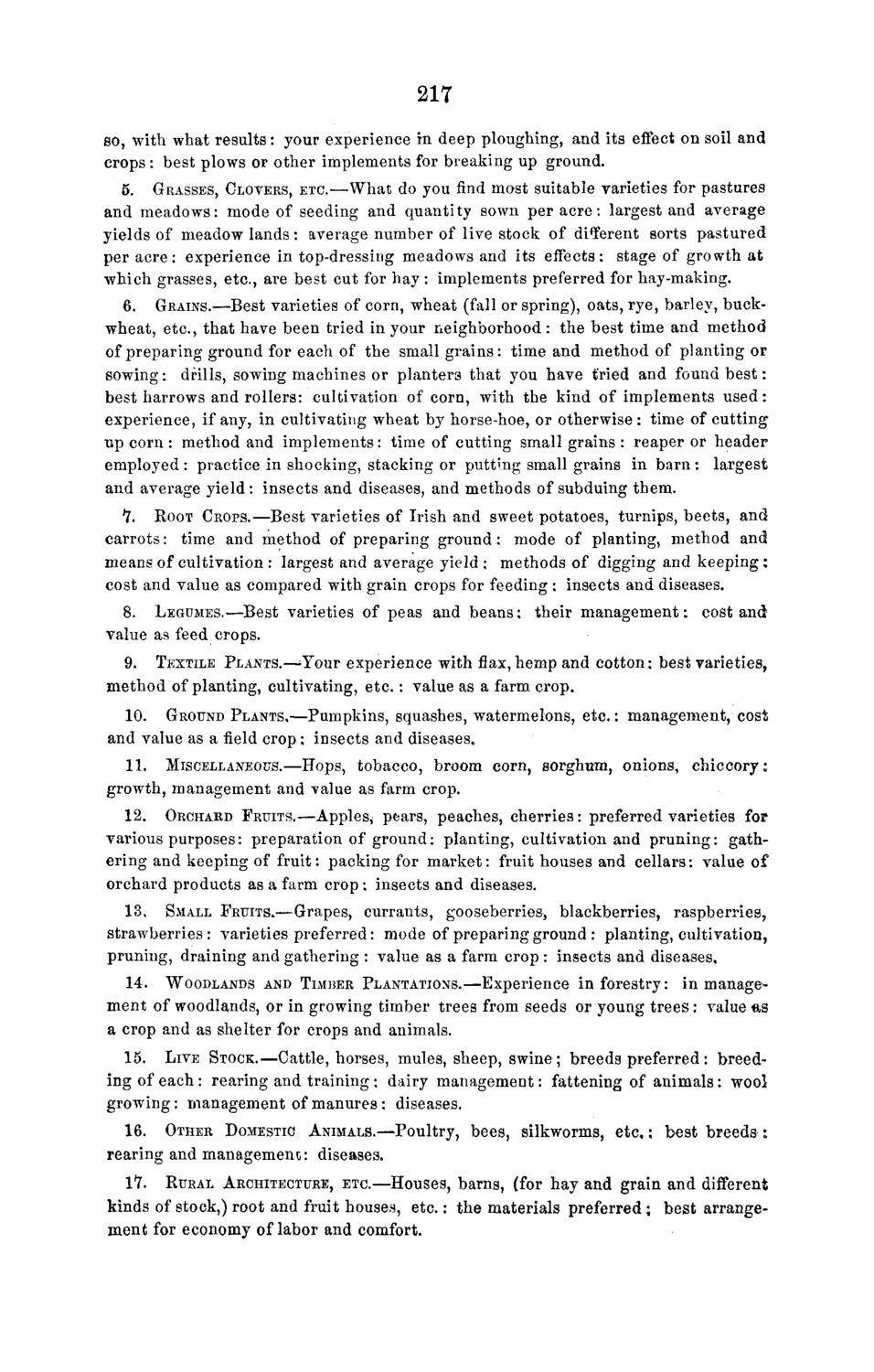| |
| |
Caption: Board of Trustees Minutes - 1868
This is a reduced-resolution page image for fast online browsing.

EXTRACTED TEXT FROM PAGE:
217 so, with what results: your experience in deep ploughing, and its effect on soil and crops : best plows or other implements for breaking up ground. 5. GRASSES, CLOVERS, ETC.—What do you find most suitable varieties for pastures and meadows: mode of seeding and quantity sown per acre: largest and average yields of meadow lands: average number of live stock of different sorts pastured per acre: experience in top-dressing meadows and its effects: stage of growth at which grasses, etc., are best cut for hay: implements preferred for hay-making. 6. GRAINS.—Best varieties of corn, wheat (fall or spring), oats, rye, barley, buckwheat, etc., that have been tried in your neighborhood : the best time and method of preparing ground for each of the small grains: time and method of planting or sowing: drills, sowing machines or planters that you have tried and found best: best harrows and rollers: cultivation of corn, with the kind of implements used: experience, if any, in cultivating wheat by horse-hoe, or otherwise : time of cutting up corn : method and implements: time of cutting small grains : reaper or header employed : practice in shocking, stacking or putting small grains in barn : largest and average yield: insects and diseases, and methods of subduing them. h I. ROOT CROPS.—Best varieties of Irish and sweet potatoes, turnips, beets, and carrots: time and method of preparing ground: mode of planting, method and means of cultivation : largest and average yield : methods of digging and keeping ; cost and value as compared with grain crops for feeding : insects and diseases. 8. LEGUMES.—Best varieties of peas and beans: their management: cost and value as feed crops. 9. TEXTILE PLANTS.—- Your experience with flax, hemp and cotton: best varieties, method of planting, cultivating, e t c . : value as a farm crop. 10. GROUND PLANTS,—Pumpkins, squashes, watermelons, etc.: management, cost and value as a field crop : insects and diseases. 11. MISCELLANEOUS.—Hops, tobacco, broom corn, sorghum, onions, chiccory: growth, management and value as farm crop. 12. ORCHARD FRUITS.—Apples, pears, peaches, cherries: preferred varieties for various purposes: preparation of ground: planting, cultivation and pruning: gathering and keeping of fruit: packing for market: fruit houses and cellars: value of orchard products as a farm crop: insects and diseases. 13. SMALL FRUITS.—Grapes, currants, gooseberries, blackberries, raspberries, strawberries : varieties preferred: mode of preparing ground : planting, cultivation, pruning, draining and gathering : value as a farm crop : insects and diseases, 14. WOODLANDS AND TIMBER PLANTATIONS.—Experience in forestry: in manage- ment of woodlands, or in growing timber trees from seeds or young trees: value «,s a crop and as shelter for crops and animals. 15. LIVE STOCK.—Cattle, horses, mules, sheep, swine; breeds preferred: breeding of each : rearing and training : dairy management: fattening of animals: wool growing: management of manures : diseases. 16. OTHER DOMESTIC ANIMALS.—Poultry, bees, silkworms, etc,: best breeds t rearing and management: diseases. 17. RURAL ARCHITECTURE, ETC.—Houses, barns, (for hay and grain and different kinds of stock,) root and fruit houses, etc.: the materials preferred; best arrangement for economy of labor and comfort.
| |